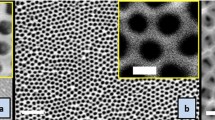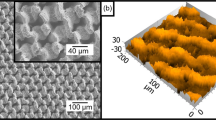Abstract
Conventional lithographic printing processes using porous alumina for offset applications generally use “wet” routes. Recently “dry” processes have been developed which are based on a heat-induced hydrophilic/oleophilic conversion of one or more layers of the coating so that a stronger affinity towards ink or water fountain is created at the exposed areas with respect to the surface of the unexposed coating. Treatments involving rf plasma-enhanced fluorination (PEF) constitute exceptional tools for modifying the surface properties of materials. Many advantages of these techniques can be indeed outlined, when compared to more conventional methods: room-temperature reactions, chemical modifications limited to surface only without changing the bulk properties, possible non-equilibrium reactions. The influence of PEF treatments on porous alumina layer used in printing plates has been tested with various fluorinated gases (CF4, C3F8 and C4F8) and characterized by XPS. The hydrophobic properties of the fluorinated layer have been deduced from contact angle measurements. Using C4F8 rf-PEF treatment, the outmost surface of the hydrophilic alumina substrate used for lithographic printing is hydrophobized, or in other words, the hydrophilic substrate is converted into a support with hydrophobic properties. Once being hydrophobized, the surface layer may be rendered hydrophilic using a heat pulse, thus giving rise to switchable hydrophobic-hydrophilic properties of the material.
Similar content being viewed by others
References
Cardinaud C, Tressaud A. Surface modification of inorganic materials by fluorination. In: Nakajima T, Tressaud A, Žemva B, eds. Advanced Inorganic Fluorides. Amsterdam: Elsevier, 2000. 437–492
Nansé G, Papirer E, Fioux P, et al. Fluorination of carbon blacks, Carbon 35. Amsterdam: Pergamon-Elsevier, 1997. 175–194, 371–388 and 515–528
Tressaud A, Durand E, Labrugère C. Plasma-enhanced fluorination of nitrile butadiene elastomer: an XPS study. In: d’Agostino R, Favia P, eds. Plasma Processes & Polymers. Weinheim: Wiley-VCH, 2005
Tressaud A, Durand E, Labrugère C. Surface modification of carbon-based materials: comparison between CF4 rf cold plasma and direct F2-gas fluorination routes. J Fluorine Chem, 2004, 125: 1639–1648
Rodriguez L M, Alcaraz J, Hernandez M, et al. Alkylation of benzene with propylene catalyzed by fluorinated alumina. Appl Catal A: General, 1998, 169: 15–27
Babel D, Tressaud A. Crystal chemistry of fluorides. In: Hagenmuller P, ed. Inorganic Solid Fluorides, Chap. 3. New York: Academic Press, 1985
Andriessen H, Brigouleix C, Tressaud A. Processless lithographic printing plate. European Patent EP 1 640 175 A1, Agfa-Gevaert, March 2006
Author information
Authors and Affiliations
Corresponding author
Rights and permissions
About this article
Cite this article
Tressaud, A., Labrugère, C., Durand, E. et al. Switchable hydrophobic-hydrophilic layer obtained onto porous alumina by plasma-enhanced fluorination. Sci. China Ser. E-Technol. Sci. 52, 104–110 (2009). https://doi.org/10.1007/s11431-008-0328-x
Received:
Accepted:
Published:
Issue Date:
DOI: https://doi.org/10.1007/s11431-008-0328-x




